The Arizona Trail is an 800 mile trail of desert and mountain. Of America’s long trails, it offers extremes and countless beautiful vistas. The trail is very loved by the thru hiker community, Arizona Trail Association and nearby towns. This Spring, I became the fastest person to complete the trail 13 days, 3 hours and 21 minutes. Very few people have experienced a multi-day, sleep-deprived endurance push and even fewer people write or talk about their experiences. With the rise of FKTs, multi-day ultramarathon events and fastpacking, I’d like to share my experiences on recovery and sleep which have been sculpted by experiences on the Long Trail, Appalachian Trail and Pacific Crest Trail.
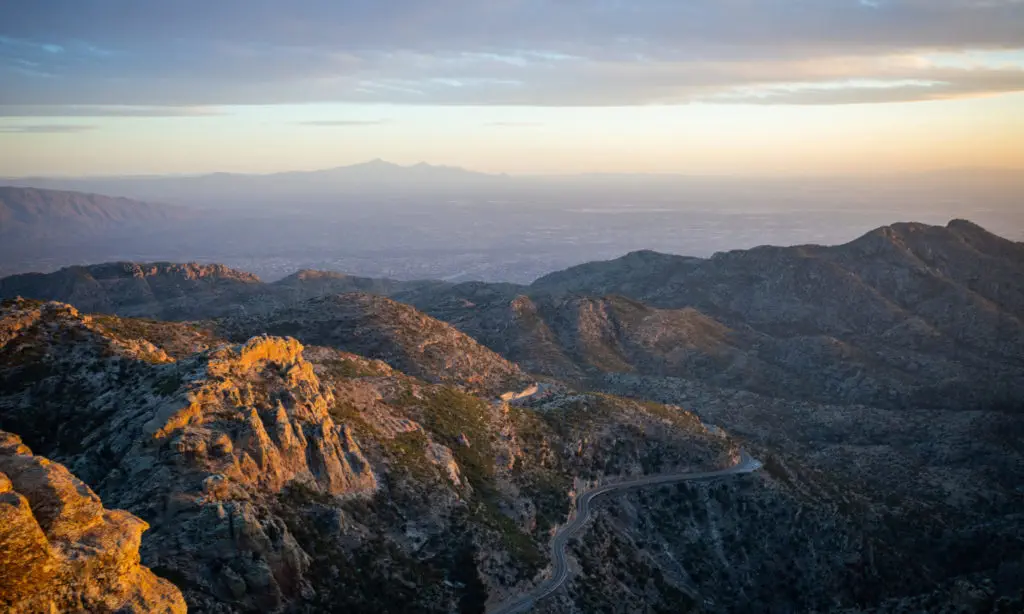
The Arizona Trail
The Arizona Trail is one of the newest long trails in the US but is captivating the long trail hiker community. In my opinion, the Arizona Trail Association is doing one of the best jobs of uniting local communities and thru hikers to create an incredible trail experience. The Arizona Trail is 788 miles long and features 118,000 ft of elevation gain, or 150 ft of elevation gain per mile. Comparatively, the John Muir Trail features 220 ft/mi, the Long Trails boasts 240 ft/mi and the Pacific Crest Trail sustains 183 ft/mi. Since I had a supported attempt, I was reliant on my support crew and road crossings for logistical stops and sleeping. Generally, these existed every 7-20 miles, with around ~10 road crossings between 20-40 miles apart.
Desert running tends to have favorable footing and wide trail, great for running. And to be the previous record holder, Josh Perry I’d have to cover least 55 miles per day. He completed the trail in 14 days and 12 hours without a support crew. My A goal was to cover almost 70 miles per day, but due to various factors I ended up averaging 60 miles per day and finishing in just over 13 days.
There is no silver bullet to setting an FKT. My crew was essential in getting me from point A to point B. How did we do it? Powering and sustaining an effort for 13 days requires significant strategy around recovery and sleep, which is the focus of this article.
Read my pre-trip thoughts here.
Click here for my FKT Recap blog post.
Click here to watch my journey in brilliantly produced 13 part vlog series.
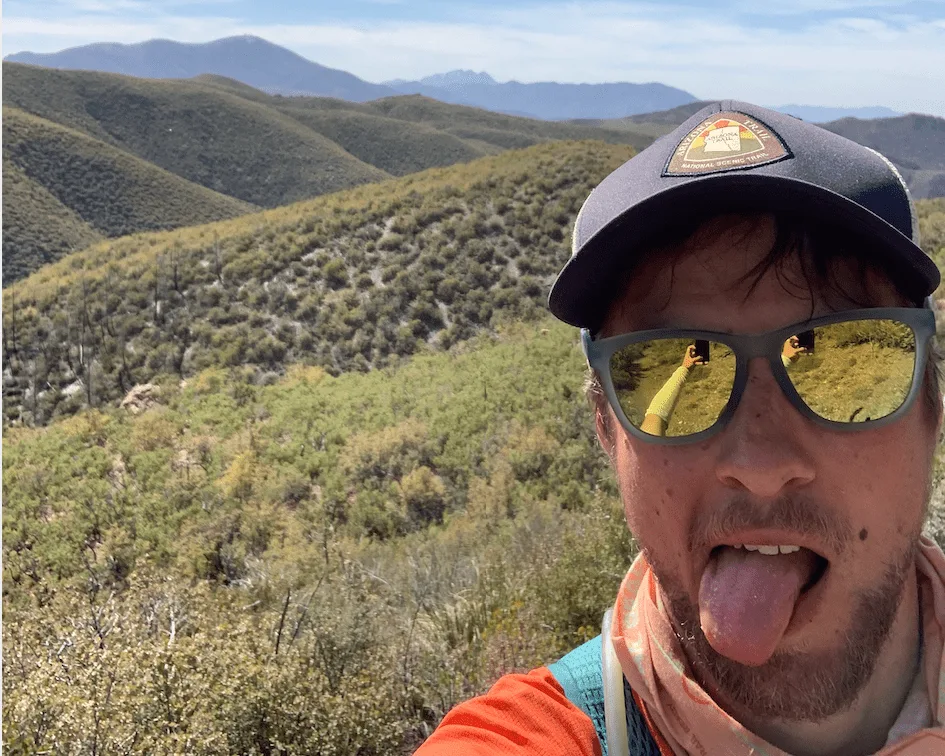
My recovery techniques for an FKT
Sleep
Sleep is the most strategic resource for multi-day endurance event. When you sleep, you promote healing, replenish muscle and liver energy stores and improve your mental state. Also, there is less demands on your heart. From a performance standpoint, I believe that a sustained and consistent sleep schedule is the key to unlocking your best come race day. When I coach athletes doing FKTs or multi-day races, we really emphasis and plan the event around sleep. Each individual has very difficult needs, so I often see a poor sleep strategy as a huge prohibitive factor for many athletes.
On the AZT, I slept around 5 hours for the first 2 nights, and then 4 hours for subsequent nights. My sleep was straight through the night. On day 10-11, I took x2 two hour naps – a strategy I employed on the Long Trail. My mental capacity was fading towards the end of the trip, however my whole strategy got blown to bits when I hit snow on the North Kaibab Plateau. After going down and up the Grand Canyon, Witt and I ran into knee- to hip-high snow. After 7 hours of postholing, we deemed it unsafe to push on. I gave up. I didn’t think I had a chance. After a full 8 hours of sleep, my crew convinced me to push on, and we were able to overcome the subsequent 20+ hours of postholing. That is a good example of my mental fortitude breaking under extreme stress until sleep helped me overcome my situation.
Additionally, I noted that, towards the latter half of the attempt, my body experienced significant swelling overnight. This makes sense because your body builds white blood cells while sleeping, and I also was consuming a lot of water and salt, which would encourage my body to hold water weight. Lastly, the skin on my feet experienced significant improvements when resting overnight.
Nutrition
By providing urine samples to Dr. Ocobok of Notre Dame, Dr. Ponzer of Duke and Dr. Best of MCLA, we discovered that I burned approximately 10,400 calories per day and drank around 13 liters of water per day over the entire endeavor. I found myself eating 5k-6k calories through the first few days, 6k-8k through the middle, and 8k+ towards the end. They are still conducting research on my biometrics.
While on trail, I primarily consumed various TrailButter nut butters and ProBar chews and bars. I supplemented that with nuts, chips, brownies, cookies, and more. At dinner, I would eat 1k-2.5k of calories. My favorite meals were burritos (especially churros!!!) and beans and rice, a classic backpacking recipe by Andrew Skurka. My least favorite meal was heaping portion of cold Olive Garden pasta with oil and meatballs. I couldn’t finish that one.
Similar to the Long Trail, I started to develop sores in the back of my throat, likely caused by the stress and rough foods. I was able to mitigate this by gargling with apple cider vinegar.
Luckily, I had a kick ass crew that was able to always deliver me the necessary calories, so I never fell into any noticeable deficit.
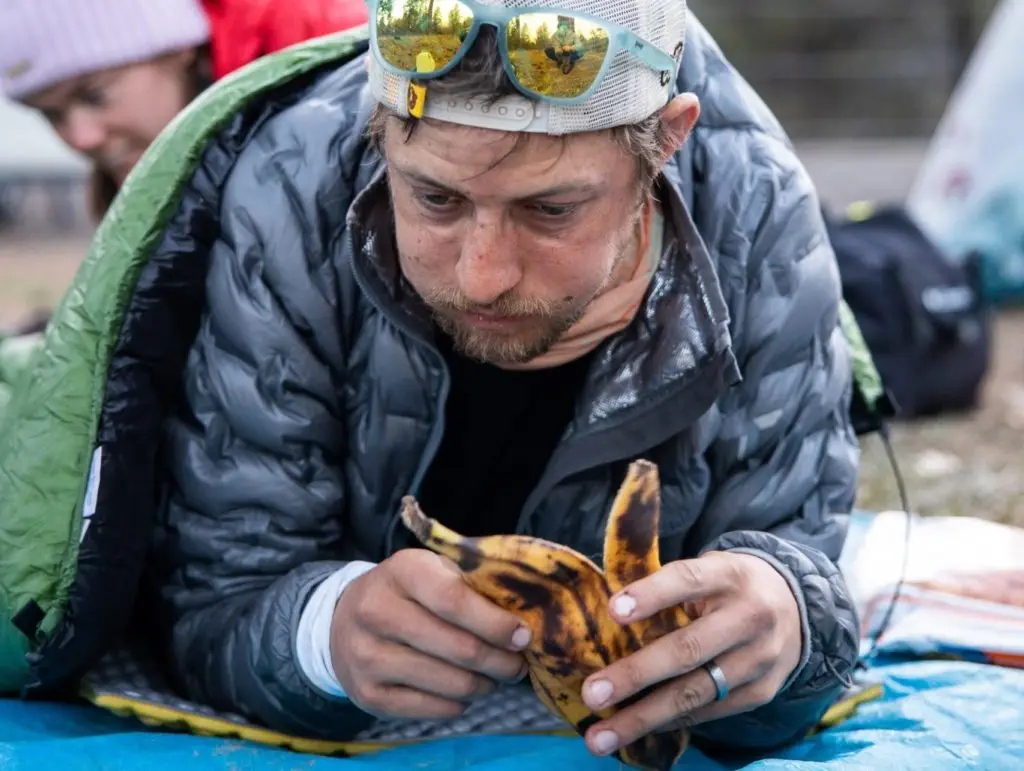
Muscle Care: Rolling Pin or Muscle Massage
I used a rolling pin and hand massage from my crew (Katie and Witt, you two are life savers!). I developed a tight hamstring on day two and neglected it for a day and a half. I believe this led to overcompensation on my right ankle and tendonitis in the achilles and retinaculum of the ankle. Rolling out become essential to keep my muscles limber. Okay, they were as stiff as 2×4’s at the end, but it kept me moving!

Ibuprofen
I also viewed Ibuprofen as critical to my progress. Chronic inflammation persisted early in the trip, a typical experience in the FKT world. I started off taking 1 ibuprofen every 6 hours to taking 3-4 ever 6 hours towards the end of the trip. If you are doing your own FKT, you should be talking to your medical provider about what they see appropriate for you.
To my knowledge, I didn’t suffer any negative repercussions from the drugs, and I believe it was essential to treating various ankle issues that surfaced.
RICE (Rest, Ice, Compression, Elevate)
In my experience, RICE is a supplemental but useful tool in FKTs. Also, maybe we should change the name from RICE to ICE, because who has time for rest? I iced occasionally, specifically for the ankle injuries mentioned below. I used compression on my lower half. When I started to develop chronic swelling/pitted edema, I believe it significantly helped stimulate blood-flow and movement of inflammation. Also, I’d elevate my legs for 15-20 minutes at the end of every day to encourage blood-flow.
Footcare
Oh boy, footcare. Witt Wisebram should give a weeklong clinic on footcare. I’m very grateful to him and my crew for getting me to the finish. I am a firm believer in Aquaphor and religiously apply every morning and night. I typically am reluctant to put any type of tape on my feet since it A) takes up time; and B) cause sometimes cause more issues that it helps. In this case, we used a fair amount of KT tape, athletic tape, moleskin and lamb’s wool to manage blisters. Additionally, we used triple antibiotic ointment to prevent infection. After day 7, I had serious foot issues. I was not properly caring for my foot hygiene and the desert finally took their toll. At this point, I began soaking my feet multiple times a day with soap to keep my skin clean, as healthy as possible and as free of grit and grime as possible. It did wonders on my feet.
I also wore toe socks to prevent blisters occurring between toes.
My sleep experiences on the Arizona Trail
How my body broke down
Feet
I was very satisfied with the combination of Columbia Montrail FKTs and Trans Alps. The FKTs were create for the cushy, well-trodden desert conditions that made up the majority of the trail and the Trans Alps were essential for the more gnarly terrain in places like the Mazatzals. However, my feet and my ankles were my two biggest liabilities on the AZT. I estimate that they slowed me down by 3-5 miles per day in the latter half of the event.
My feet maintained through a huge day up Mica and Mt. Lemmon on day 3, but I first noticed my feet on day 4. They started to burn later in the day, but I was so focused on crushing a big day that I neglected them as I cruised through an 78 mile day. Next day, big mistake. My feet were uncomfortable in my shoes, and I walked the first 2 hours in discomfort, but eventually they warmed up and I started moving again.
Compared to my experiences on the PCT, AT and LT, I had more foot problems this time around. There is something to be said about the grit and sand that penetrate your socks, as well as the general heat that seem to amplify food issues. Additionally, I pushed for longer days with less sleep than any other FKT than I have done. My theory is that my feet had a more difficult time performing due to less sleep.
They didn’t seriously become an issue until the morning of day nine. At this point, I’d developed a large blister on my pinky toe caused by my pinky toe rubbing underneath my 4th toe. The extra dressing on my feet and general inflammation required me to size up to a size 13 Columbia Montrail FKT. While I love the shoe, the narrower fit that leads to great stability and control became an issue which was solved by sizing up.
The aforementioned foot care regime that we adopted after day 7 was critical to my success. Despite putting 17+ hours of time on feet per day on my feet, I could see my skin and existing blisters healing over the last few days – despite being constantly soaked from post holing.
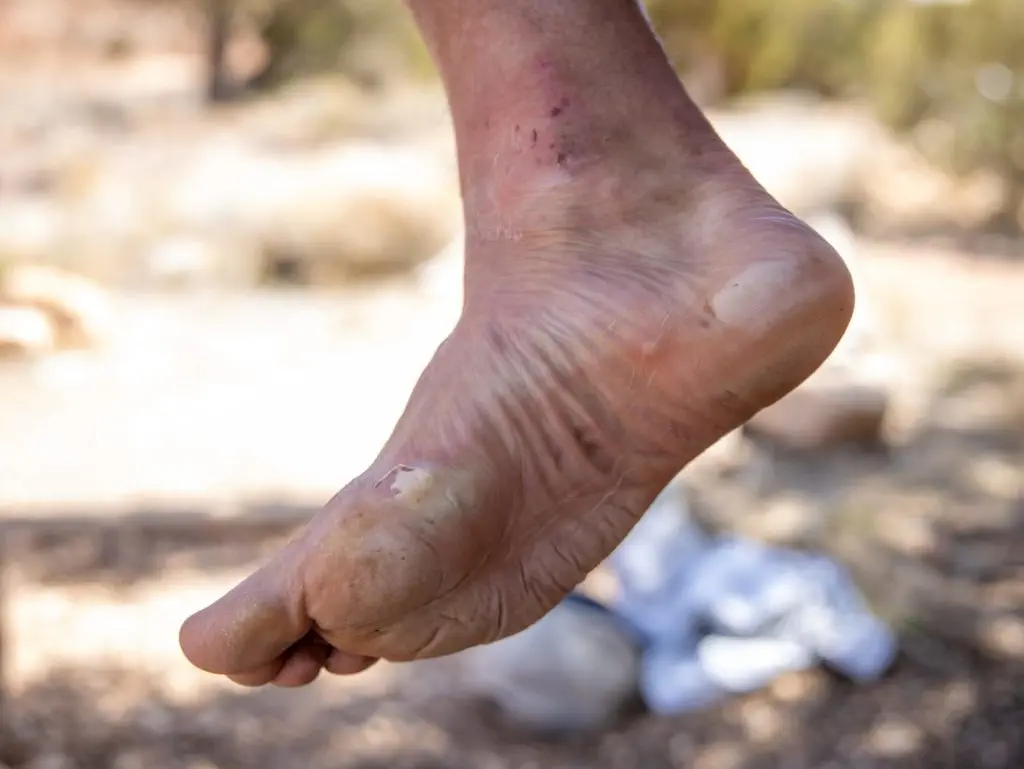
Right foot tendonitis
I visited a great orthopedic doctor after finishing the Arizona Trail, Dr. Anderson. ‘You look great. Very healthy considering the circumstances,’ he said, ‘but you have a bone spur at the base of your tibia.’ Located right at the ankle joint, a small bone spur developed that, when stressed by hundreds of miles of trail running, acted up causing inflammation around my ankle joint.
As early as day two, I experienced slight swelling and tightness in my right ankle. It started with some strong muscle tightness in my left hamstring, and I noticed myself compensating slightly and felt it in my ankle a half day later.
The ankle swelling reminded me of the Pacific Crest Trail 7 years prior. I lost the majority of mobility in both my ankles concurrent with swelling and pain. I stuck out the PCT for the last 2 weeks, and knew I would have to do the same here. By day 5 or 6, the combination of blisters and ankle tightness made me very ginger around technical terrain. My ankle was particularly trashed by all the post holing. Around Flagstaff and north of the Grand Canyon, we ran into significant snow. The unstable footing irritated my ankle, and I became worried that it would force me to withdraw from the whole effort.
In the end, my ankle help up reasonably enough!
Left achilles tendonitis
I experienced some tightness on my left achilles on day six. I was worried that my achilles would balloon out of control like my right ankle, but it was kept in check most of the time. The achilles pain was aggravated by the snow towards the end, and was always in the back of my mind at the end of each day that I was slowly breaking down.
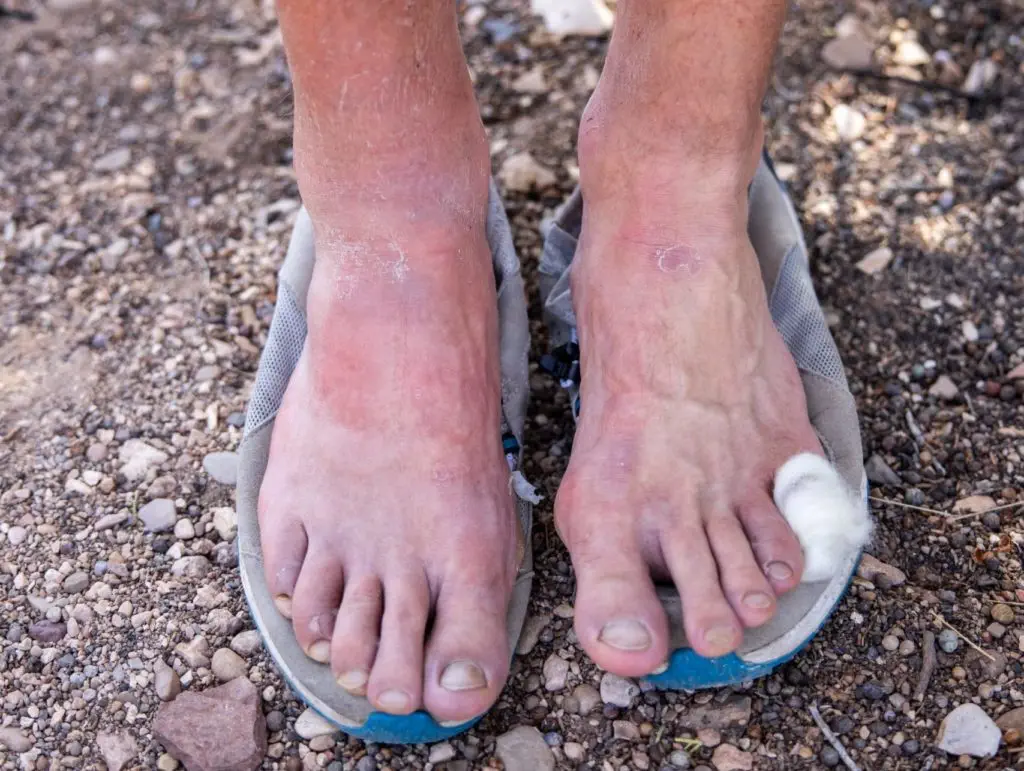
Left hamstring tightness/tendonitis
Frequent roll outs is essential if you are pushing your body to its extreme limits. I was made painfully aware of that reality when I neglected to take care of my hamstrings as early as day one and day two. I first developed tightness in my left hamstring on day 2. After that, I became very adamant about rolling out, which I believe allowed me to push an extra few hours per day. That being said, I had mild tendonitis for the rest of the journey.
Forearm tendonitis
I wore my COROS Vertix and an activity tracker band to provide movement data for the researchers who I teamed up with. The band was tied too tight around my wrist, and I realized that after a few days I was developing tendonitis. After 5 or 6 days, I moved the watch and the activity tracker to my right forearm because my left forearm was no longer able to tolerate the pain caused by the pressure. Eventually, my right wrist also became inflammed. I then switched back to my left wrist, which in turn became too painful again. I played this song and dance through the whole second half.
It only seriously affected my performance a few times when I had a hard time gripping my trekking poles or holding food.
Sunburns
The sunburns weren’t too bad, other than my ears. Despite constant application of sunscreen (okay… that may be a lie), my ears were constantly burned. This became problematic when I started to develop sunburn blisters on my ears. Additionally, I was an idiot and forgot to wash my face during the first half of the trip. This caused my face to break out to some extend. As it turns out: little sleep + 18 hours of running + desert dust + sunscreen + no washing = breakout. Who would’ve thought!
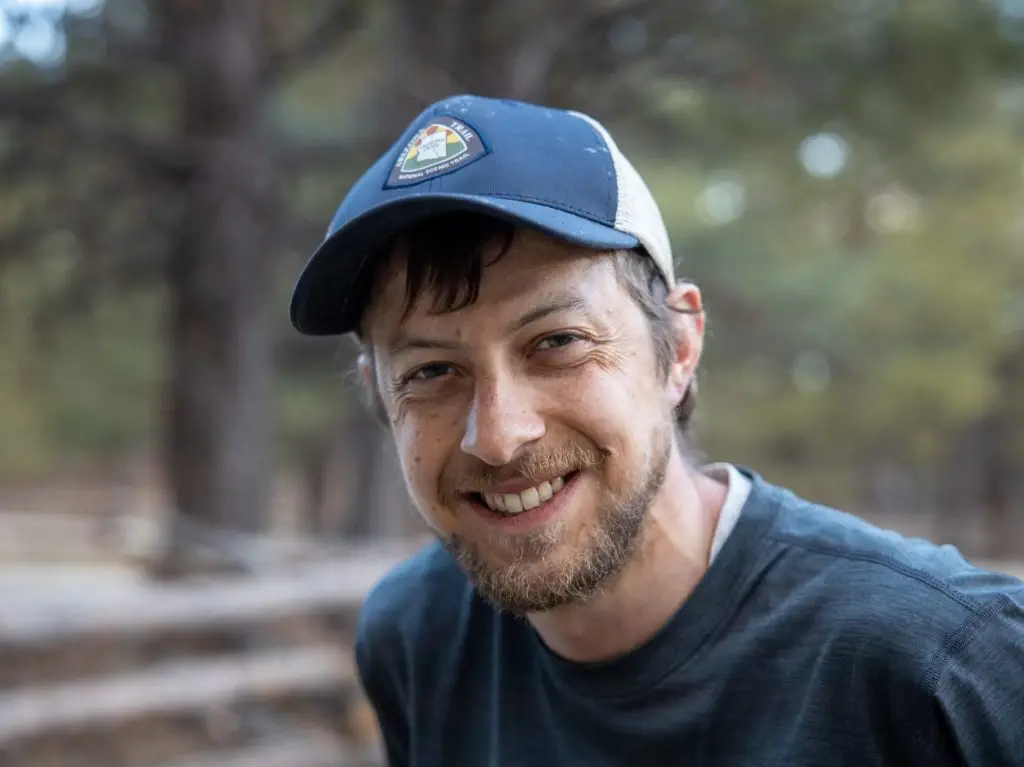
Long term recovery: Did I sustain any lasting injuries?
If you’ve made it this far in the article you’re probably thinking two things. A) This guy is psycho; and, B) … Is he still alive?
The good news. I’m still kicking! Not quite sure on the sanity front, though. You’ll have to make your own judgement there.
Through all my running, as a middle/high schooler, collegiate athlete at Boston College, ultrarunner and FKT athlete, the most serious injuries I’ve sustained were during my freshman and sophomore year in college. Since then, I’ve never had any physical issues that have thrown off my training for more than a week.
Immediately following the AZT, I guided for 17 days in Utah with Andrew Skurka. I had some serious issues around my right ankle and the bottoms of my feet. However, 6 days after finishing the AZT, I was able to hike through ambitious off-trail routes with a full backpack.
After that trip, I visited Dr. Anderson to get my ankle checked out. We took x-rays which he was able to compare to 2014 x-rays when I visited him 7 years prior. He was able to point out one notable bone spur at the base of my tibia that didn’t exist 7 years ago. Additionally, there were one or two other spots that possibly could be bone spurs. He informed me that bone spurs don’t grow overnight – I’d likely had this bone spur for at least a year. While I would always have a structural risk for injury of my ankle due to the bone spur, it was minimal. It took 60+ mile days to show itself. At this point, I had a lot of soft tissue in and around the joint capsule of my ankle that was recovery. Once that goes down, I should be back to normal!
About a month after finishing the AZT, I started running again. You can view my training here. My body felt pretty much fully recovered, however I was experiencing achilles pain on my right side. I kept my mileage at 30-40 miles per week for the next 7 weeks until I finally started to feel better.
Then, I poured on the mileage with a good with of training with Drew Kiracofe, Katie’s younger brother who is a sub-2:40 marathoner. Life was good until I felt my back tighten up. Three days later, I limped down the side of a Cougar Mountain on a group run with Cowgill Trail Elite. My hip got so tight and painful that I couldn’t run on it. It’s taken about 2 weeks for my hip to loosen up, and that is where I sit now writing this article.
Is the back injury related to the Arizona Trail? I suspect it is. I’ve appreciated a remarkably healthy career, and I hope to continue that by continuing to employ a proper balance of running, strength and rest as an athlete!
This post contains affiliate links. I earn a small commission on sales via these links at no additional cost to you. If you'd like to support me, please purchase products through the affiliate links. Thanks!

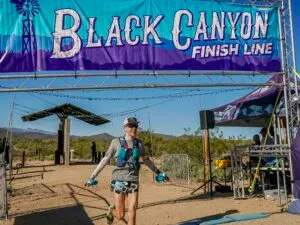

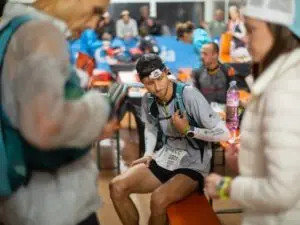
Awesome read. Way to push through, but now time to take care of yourself so you can get back to it!
This was great to read all the detail on your thinking and how the execution of your plan turned out. Even better is reading the blog in conjunction with the YouTube videos and your Strava record. Gives a super clear picture – thanks!
Do you think the sores in the back of your throat were related to indigestion from eating so many calories and I’m guessing then running immediately after?
And if so, do you think there is a remedy that might work better than the Apple Cider Vinegar?
No, I’d attribute them more to stress, fatigue, harsh foods and acids. I’ve assumed it has similar triggers to Transient lingual papillitis which is also common to get on FKTs. I don’t really get indigestion during FKTs (or at least, I don’t notice much indigestion) as much as I get lackadaisical on cleaning my mouth.
Candice Burt had a similar but much more pronounced throat sores that caused her to get off trail in ~4 days.
Brushing my teeth has always felt like a key preventative measure. I’d assume a x2 daily mouthwash would help. I would also try other homeopathic mouth rinses, like tea tree oil or throat coat tea.